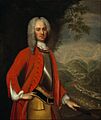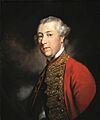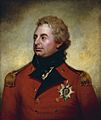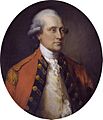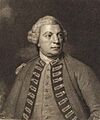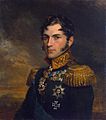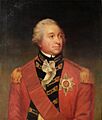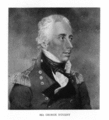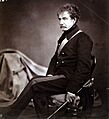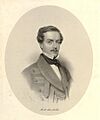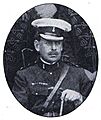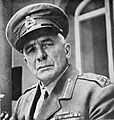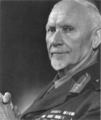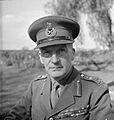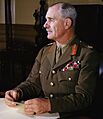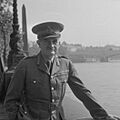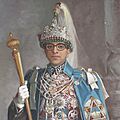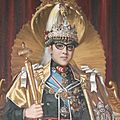Field marshal (United Kingdom) facts for kids
Quick facts for kids Field Marshal |
|
|---|---|
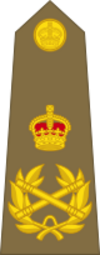
The insignia of a field marshal as worn on epaulettes
|
|
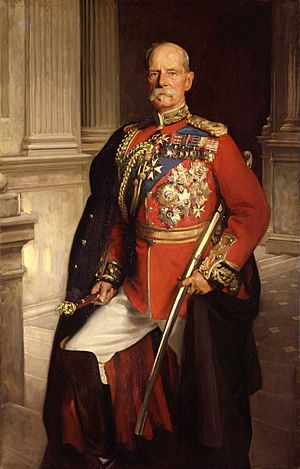
The Earl Roberts painted 1906 in the full dress uniform of a Field Marshal in the British Army
|
|
| Country | United Kingdom |
| Service branch | British Army |
| Abbreviation | FM |
| Rank | Five-star rank |
| NATO rank | OF-10 |
| Non-NATO rank | O-11 |
| Formation | 1736 |
| Rank group | Flag officer |
| Next higher rank | none |
| Next lower rank | General |
| Equivalent ranks | Admiral of the Fleet (RN) Marshal of the Royal Air Force (RAF) |
A Field Marshal (often shortened to FM) is the highest rank in the British Army. This special rank has been around since 1736. It's like a "five-star" rank, which means it's super important!
This rank is equal to an Admiral of the Fleet in the Royal Navy (the UK's navy) or a Marshal of the Royal Air Force in the Royal Air Force (the UK's air force).
The symbol for a Field Marshal is two crossed batons (like fancy sticks) surrounded by golden leaves. Above them is a crown. Once someone becomes a Field Marshal, they usually stay an officer for life, even after they retire.
Over time, how Field Marshals are appointed has changed. After World War II, it became common for the head of the army, called the Chief of the Imperial General Staff (now Chief of the General Staff), to be promoted to this rank on their last day in the job. Also, army officers who became the overall head of all British armed forces, the Chief of the Defence Staff, were usually promoted too.
In total, 141 people have held the rank of Field Marshal. Most of them were professional soldiers who worked their way up through the ranks. Some members of the British Royal Family, like Prince Edward, Duke of Kent and Charles III, also became Field Marshals. Three British Kings (George V, Edward VIII, and George VI) got the rank when they became king. Two royal consorts (husbands of queens), Albert, Prince Consort and Prince Philip, Duke of Edinburgh, were also given the rank by their queens.
Sometimes, foreign leaders were given the rank as a friendly gesture between countries. Twelve foreign monarchs (kings or emperors) held this honour. However, three of them (Wilhelm II, German Emperor; Franz Joseph I, Emperor of Austria-Hungary; and Hirohito, Emperor of Japan) had their ranks taken away. This happened when their countries became enemies of Britain during the two World Wars. Other famous people who became Field Marshals include a French general (Ferdinand Foch) and an Australian general (Sir Thomas Blamey), who were honoured for their help in World War I and World War II. A South African leader (Jan Smuts) also received the rank.
Contents
Why the Rank Changed
In 1995, the Ministry of Defence looked for ways to save money in the armed forces. One idea was to get rid of all "five-star" ranks, including Field Marshal. The reason was that these ranks seemed too high for the size of the armies these officers were leading. Also, many of Britain's allies, like the United States, usually only used such high ranks for officers who commanded huge armies in major wars.
The idea to completely get rid of the rank wasn't fully adopted. But the practice of regularly promoting service chiefs to five-star ranks was stopped. Now, these ranks are mostly saved for very special situations. Sir Peter Inge was the last active officer to be promoted to Field Marshal in 1994.
Recent Promotions
The most recent promotions to Field Marshal happened in 2012. This was 18 years after the regular promotions stopped. Queen Elizabeth II promoted her son and heir, Prince Charles (now King Charles III), to the five-star ranks in all three services. This was to recognise his support for her as the head of the British Armed Forces.
At the same time, Charles Guthrie, who had been the Chief of the Defence Staff, was promoted to an honorary Field Marshal. In 2014, another former Chief of the Defence Staff, Lord Walker of Aldringham, also became an honorary Field Marshal.
Even though the Royal Marines don't use the Field Marshal rank, its symbol is worn by their ceremonial head, the Captain General.
Insignia of Rank
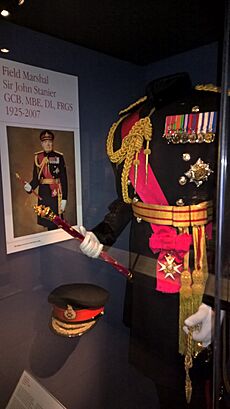
The symbol for a Field Marshal in the British Army shows two crossed batons. These are surrounded by a wreath of laurel leaves, with a crown on top. In some other countries that were influenced by Britain, a similar symbol is used. However, they might replace the crown with their own cultural or national emblem. When a British officer becomes a Field Marshal, they receive a special gold-tipped baton. They can carry this baton on formal occasions.
Famous Field Marshals

Most Field Marshals were professional soldiers in the British Army. Eleven of them served in the British Indian Army. Many Field Marshals were wounded in battle earlier in their careers. Some were even prisoners of war.
Fifteen future Field Marshals were at the Battle of Vitoria. This is where the Duke of Wellington earned his rank. Ten others fought under Wellington at the Battle of Waterloo. However, only 38 Field Marshals led independent commands in battle. Just 12 were the professional head of the army during a major war.
Four Field Marshals received the Victoria Cross (VC). This is the UK's highest award for bravery in the face of the enemy.
- Sir Evelyn Wood earned his VC for attacking rebels in India and rescuing someone.
- Sir George White led brave charges on enemy guns in Afghanistan.
- Lord Gort commanded attacks while severely wounded during World War I.
- Earl Roberts received his VC for actions during the Indian Mutiny.
Wellington was the youngest non-royal officer to become a Field Marshal. He was 44 years old. Charles Moore, 1st Marquess of Drogheda was the oldest, promoted at 91. Wellington was also the only Field Marshal to become Prime Minister of the United Kingdom.
No British Army officer has reached the rank of Field Marshal without serving in certain types of units. These include the cavalry, infantry, Royal Armoured Corps, Royal Artillery, or Royal Engineers.
One non-British officer, Ferdinand Foch of France, was appointed Field Marshal in the British Army. This was to recognise his important help in World War I. Also, Sir William Robertson is unique. He held every rank in the British Army, from a private soldier all the way up to Field Marshal!
Images for kids
See also
- British Army Other Ranks rank insignia
- Admiral of the Fleet (Royal Navy)
- Marshal of the Royal Air Force
- British Army officer rank insignia
- British and U.S. military ranks compared







